Please put an active hyperlink to our site (www.rusnature.info) when you copy the materials from this page
Environmental problems of Northern Eurasia
Environmental Impact of Oil and Gas Development
Oil and Gas Development: Environmental and Social Impacts
<<< Hydrocarbon Industries: A Brief
Overview | Environmental Problems Index | Clean-up Practices and Restoration of Ecosystems >>>
Environmental Impacts of Oil and Gas Production
By virtue of oil and gas production being concentrated mainly in the Russian north,
this territory suffers environmental disruption at the largest scale. The southern tundra
and forest-tundra biomes of Yamal have been affected most strongly (Table 20.3).
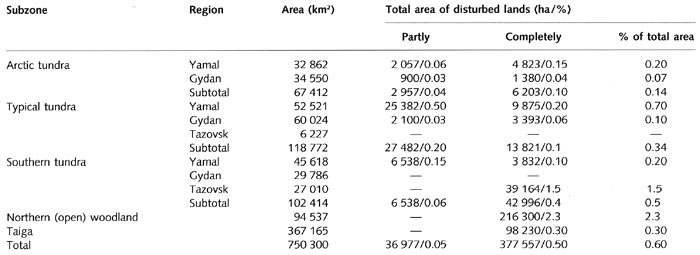
Table 20.3 Distribution of the mechanically disturbed soils in the YNAO
The impacted areas significantly exceed the areas allotted for industrial use. For
example, 2 per cent of the total Yamburg gas field (the second largest in Russia) area was
allotted to gas industry installations. Analysis of satellite data, however, has shown
that the vegetation cover and upper soil horizons are completely destroyed within 5 per
cent of the area; the area of strongly disturbed vegetation (biomass decreased by 40 per
cent to 60 per cent) covers approximately 15 per cent of the territory; and damaged
vegetation (biomass decreased by 20 per cent to 30 per cent) occupies another 25 per cent
(Vilchek and Bykova, 1992). Clearance of vegetation and soil disturbance can cause
degradation (thawing) of permafrost (French, 1996). Construction works and the movement of
heavy vehicles over permafrost in summer when the surface is thawed are the main sources
of land disturbance (Plate 20.1).
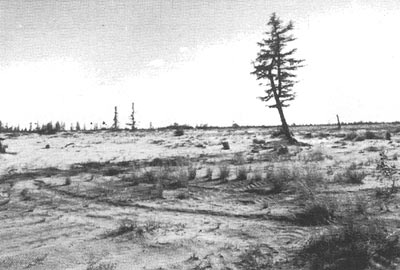
Plate 20.1 Soil erosion in the tundra (photo: G. Vilchek)
In Russia, it is a common practice to relocate drilling derricks and heavy equipment by
connecting a few tractors to a single vehicle that 'ploughs up' the tundra, forming deep
furrows that trigger soil erosion and thawing. As vehicle tracks become filled with water
and mud, new routes are picked alongside the existing ones. Drilling pads, which are
located at a short distance from each other, have their own access roads, pipes, and
powerlines. The use of modern technology could replace up to twenty of such pads with a
single drilling point (Pearce, 1993). Warm oil pipelines running through permafrost
terrain cause thermal disturbance (Plates 20.2 and 20.3).
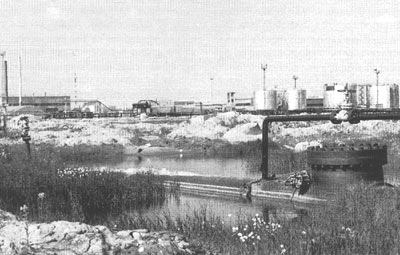
Plate 20.2 Thermokarst developing around oil pipelines (photo: G.
Vilchek)
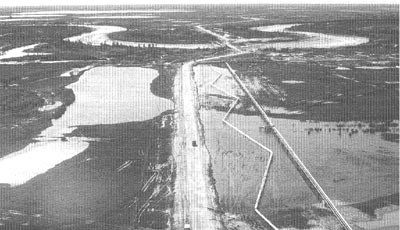
Plate 20.3 Yamal: pipelines running through the tundra (photo: G.
Vilchek)
To minimize the problem, raised pipelines are constructed and most of the minor
pipelines, connecting wells and processing facilities are of this type. However, few of
the trunk pipelines are the raised ones with the notable exception of the world's
northernmost Messoyakha-Norilsk pipeline, connecting the gas fields of the Gydan peninsula
with the non-ferrous smelters of Norilsk. The raised gas pipelines are, however, not an
ideal solution since they are prone to accidents.
Chemical and oil pollution, resulting from the spreading of solutions used to ease
drilling, discharges produced by drilling installations (which consist of clay, alkalis,
cement slurry, and diesel fuel), oil escaping from boreholes and, most importantly, oil
spills have significant impacts on biotic complexes. A single oil well produces
approximately 40 000 m3 of wastes which are usually buried in pits dug nearby
(Pearce, 1993). While Western environmental regulations require that such pits have an
impermeable lining, there is no such requirement in Russia. Sand and soils provide no
protection from oil percolating underground. A simple system of oil collection and surface
water drainage could significantly reduce pollution. However, these methods are not
commonly used. Harsh environmental conditions and poor maintenance lead to frequent oil
spills (accidents in the north occur much more often than in the Volga-Urals and Caspian
regions). Over 600 large oilpipe breaks are registered annually in the Ob basin with 3-10
million tonnes of oil being spilled. Smaller accidents are much more frequent; 3 5 000
accidents leading to oil spills were registered in 1996 across Russia.' Each year between
7 per cent and 20 per cent of extracted oil (between 15 and 20 million tonnes) is lost
through accidents on the Russian pipelines (Kutsenko and Danilina, 1997), which
significantly exceeds a planned loss of 2 per cent. It is estimated that between 30 per
cent and 50 per cent of pipeline accidents occur as a result of steel corrosion, with
probability of a spill growing with the duration of pipeline exploitation. At present,
about a half of all oil pipelines in Russia are over 20 years old and in need of
replacement. About 30 per cent of accidents are accounted for by the low quality of pipes
and poor welding and between 5 per cent and 20 per cent of accidents occur due to
unintentional damage such as hitting by vehicles (Mironyuk, 1993). The gas pipeline
system, although in need of refurbishment, is in a better position. Despite the ageing of
pipelines, the number of accidents has been declining since the mid-1970s and through the
1990s due to a better quality control by Gazprom (IEA, 1995).
One of the largest accidents in the history of oil industry in Russia was the Usinsk
oil spill, which occurred in 1994 on the Vozey-Usinsk pipeline, delivering 90 per cent of
the Komi Republic's oil (Vilchek and Tishkov, 1997). The accident received much attention
from the international media. According to the estimates made by the State Committee on
Hydrometeorology and Environment and Geopolis Joint Stock Company, approximately 120 000
tonnes of oil were released and an area of 70 km2 (Figure 20.3) was
contaminated (UNEP, 1994).
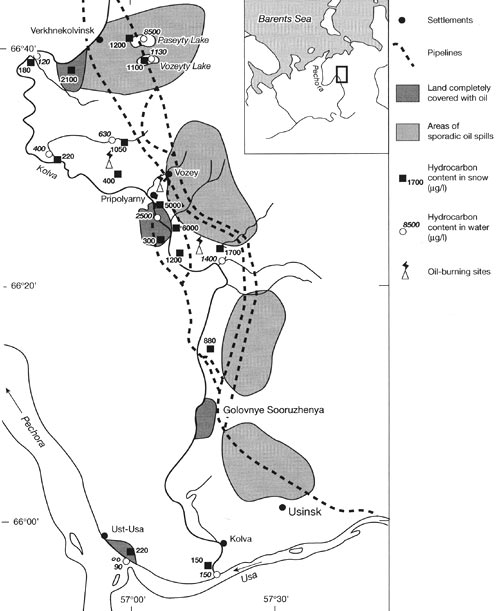
Fig. 20.3 Pollution caused by the Usinsk oil spill. After Vilchek and
Tishkov (1997)
Exploitation of the pipeline began in 1975 and the first accident leading to an oil
spill occurred in 1988. Thirty breaks on the pipeline leading to oil leaks had been
registered between 1988 and 1994. However, the operation of the pipeline had never been
terminated. Even throughout the time of the Usinsk accident, it continued to pump oil.5 As
a result of the accident, extremely high levels of pollution by petroleum products
occurred: concentrations of benzol in the upper horizons of soils reached 12 mg g-1
and levels of xylol were as high as 3 mg g-1, exceeding the Russian standards
by a factor of 38 and 60, respectively. Concentrations of oil in snow varied between 1000
ng 1-1 and 2000 ng 1-1 with a maximum registered concentration of
6000 ng l-1. The clean-up attempts involved burning oil which in turn had led to the
release of such highly toxic hydrocarbons as benzo(a)pyrene and benzoperylene into the
atmosphere. Concentrations of benzo(a)pyrene in snow around the places of oil burning
reached 34 ng l-1 and concentrations of benzoperylene were as high as 32 ng 1Ћ
Most of the spilled oil was accumulated in mires. However, a large proportion of it was
transported to the Kolva, Usa, and Pechora rivers. Concentrations of petroleum in water
varied between 8500 mg l-1 in proximity to the points of release and 150 mg l-1
in the mouth of the Kolva river. Oil films on the water surface of rivers Kolva and Usa
reached 10 km in length, and covered about 70 per cent of the water surface of the Pechora
river (Krupenio et al., 1995). Accumulation of oil in the bottom sediments had led to
considerable contamination of sediments with concentrations reaching 14 mg g-1.
Large oil spills (of the Usinsk spill magnitude) occur once in two or three years. Thus,
an accident leading to the release of 500 000 tonnes of oil occurred in the Tyumen oblast
in July 1990; 420 000 tonnes of oil spilled to the Ob river in the spring of 1993; in
1996, 3 million tonnes of oil was spilled in the river Bolshoy Balyk as a result of a
pipeline accident in the KMAO in Western Siberia (Kutsenko and Danilina, 1997). In the
context of insufficient investment, the extreme environmental conditions which cause the
rapid wear of equipment is the main reason for accidents on the pipelines of the north.
However, the fact that work at oil- and gasfields of Siberia is performed by migrants,
drawn to the north by high wages, may also be a contributing factor. Thus, in the
mid-1980s, one-third of the drilling work in the Tyumen oblast was performed by the shift
method by workers flying from the Volga region (Lavrov, 1991). The lack of concern by
migrants for the natural environment of the north, combined with the low priority of
ecological issues for the oil companies, are other contributing factors (Arikaynen, 1991;
Lavrov, 1991; Chance and Andreeva, 1995).
Serious problems are associated with the aftermath of oil pollution. Oil can be
diffused into the soil profile to a depth of 50 cm, which leads to soil contamination,
increase in soil density, rise of salinity, and surface cracking (Solntseva, 1995).
Lichens, moss, and shrubs suffer major damage; the tree cover survives if oil covers less
than 20 per cent of the surface (Gashev et al., 1989; Vegerin et al., 1989). Low
temperatures retard biochemical processes, controlling breakdown of pollutants, and
plant-growing rates in the north, and because of it the self-cleansing capacity of the
ecosystems is low. Natural recovery of soil and vegetation contaminated by oil takes 50-60
years (Bratsev, 1988). Oil pollution affects wildlife, particularly fish and waterfowl
birds. Lemmings are often trapped in small depressions filled with oil while diving birds
die through drowning or toxic effects of ingested oil (Balakhonov, 1988). Contamination of
nesting bird eggs results in death of the embryo through asphyxia (Braude, 1987). A total
of 370 000 tonnes of oil and petroleum products were transported to the Arctic Ocean by
the rivers Ob and Yenisey (Federal Report, 1997). Although, overall the content of
dissolved petroleum hydrocarbons in the Russian sector of the Arctic Ocean does not exceed
the standard of 0.05 mg l-1 (Roginko, 1991), high concentrations are frequently
observed in estuaries of rivers that drain the oil-producing areas. Thus, over 120 000
tonnes of dissolved hydrocarbons, including highly toxic benzol and benzo(a)pyrene, are
annually delivered to the Ob delta. Concentrations of petroleum in water exceed a standard
of 0.3 mg l-1 by a factor of 10 and in the bottom sediments by a factor of 20
(Federal Report, 1993). This area provides a habitat to commercially valuable species
offish. Pollution by hydrocarbons leads to the reduction of dissolved oxygen contents in
water which is particularly damaging in the northern context because the Arctic fish
species require high levels of oxygen concentrations (Rusanov, 1985). Contamination of
bottom sediments damages larvae, destroys wintering pits and spawning grounds and
decreases the possibility of normal reproduction. According to the Siberian Institute of
Fishery, about 1200 streams and 250 rivers have lost their marketable fish resources due
to pollution (Western Siberia North, 1992). It is estimated that in the Tyumen oblast 18
500 tonnes of fish is lost annually due to pollution from the oil industry (Mazur et al.,
1990). The loss of wildlife has a critical impact on the welfare of indigenous peoples
(Khants, Mansis, and Selkups) for whom hunting and fishing are traditional occupations.
Oil pollution may have wider implications. The penetration of petroleum products into snow
cover and rivers may bring about changes in heat, moisture, and gas exchange processes
between the ocean and the atmosphere. Oil films reduce evaporation by approximately 50 per
cent and the ice growth rate by a factor of 1.5 (Rusanov, 1985). Oil films decrease albedo
of ice and snow by 10-35 per cent, resulting in earlier and more intensive melting. In the
spring and summer, snow melts 5-10 times faster in polluted areas than in the clean
environment (Izmailov and Simonov, 1986).
The hydrocarbon industry is a large source of air pollution. Natural gas, which occurs
in the upper strata and is characterized by low productivity, is not processed but burnt
in torches. In Western Siberia, over 19 billion m3 of natural gas is burnt
annually (Vilchek et al., 1996). Drilling wells are another source of atmospheric
emissions (Table 20.4).

Table 20.4 Annual emissions of atmospheric pollutants produced by a
single gas well (tonnes)
Deposition of atmospheric pollutants in close proximity (500 m) to oil wells reaches
4.4 kg m-2 (Voevodova, 1988). Deposition of dust and hydrocarbons on snow leads
to early snow melting and degradation of permafrost. The amount of artificial heat
produced by burning natural gas is comparable with the annual radiation budget of the area
(Pokrovskaya, 1988). Mass deaths of migrant birds in gas torches are widely known
(Paskhalny, 1988).
<<< Hydrocarbon Industries: A Brief
Overview | Environmental Problems Index | Clean-up Practices and Restoration of Ecosystems >>>
Contents of the Environmental Impact of Oil
and Gas Development section:
Other sections of Environmental Problems of Nortern Eurasia:
|
|